Agri-Facts: Poplar and Willow Blotch Leafminers
While there have been many reports to our Tree Specialist, Toso Bozic, regarding leaves deformed by various blotch leafminers, neither Poplar or Willow Galls and Leafminers pose any significant threat to the health of trees or shrubs. It is cosmetic insect damage and there are many natural enemies in place to regulate the population of the offending insects.
See below for more information on the different types of leafminer damage you could be experiencing and how to identify it.
Willow Leafminer - PDF Download
The willow leafminer (Micruapteryx salcifoliella) is a small, grey moth native to North America. The caterpillars of this moth feed on willow leaves periodically, causing extensive damage to willow stands in the province. In 2011, an interprovincial outbreak of this insect damaged vast tracks of willow stands in Alberta.
How to Recognize Willow Leafminer Damage:
- Dead and discloured areas (necrotic blotches) on the upper surface of the leaves, normally in June. These blotches are distinct at first but connect together later.
- Caterpillars of this moth feed on the upper surface of willow leaves first and then begin feeding inside (mining) the leaves between the upper and lower surfaces of the leaves.
- Damaged leaves turn reddish brown
- Premature drop of damaged leaves
- Damaged area of the leaf is found hollow with caterpillar droppings and sometimes with small (4-7mm long), flat, plae yellow caterpillar mining between upper and lower layers, if the damaged leaf is pulled apart.
- Mature caterpillars make cocoons to enter into a transition stage (pupa) in July, during which the aduly moths develop. The cocoon has a cellophone-like covering with a ring of denser silk around its margin. Cocoons are mostly located on the upper surface near the tip of the leaf.
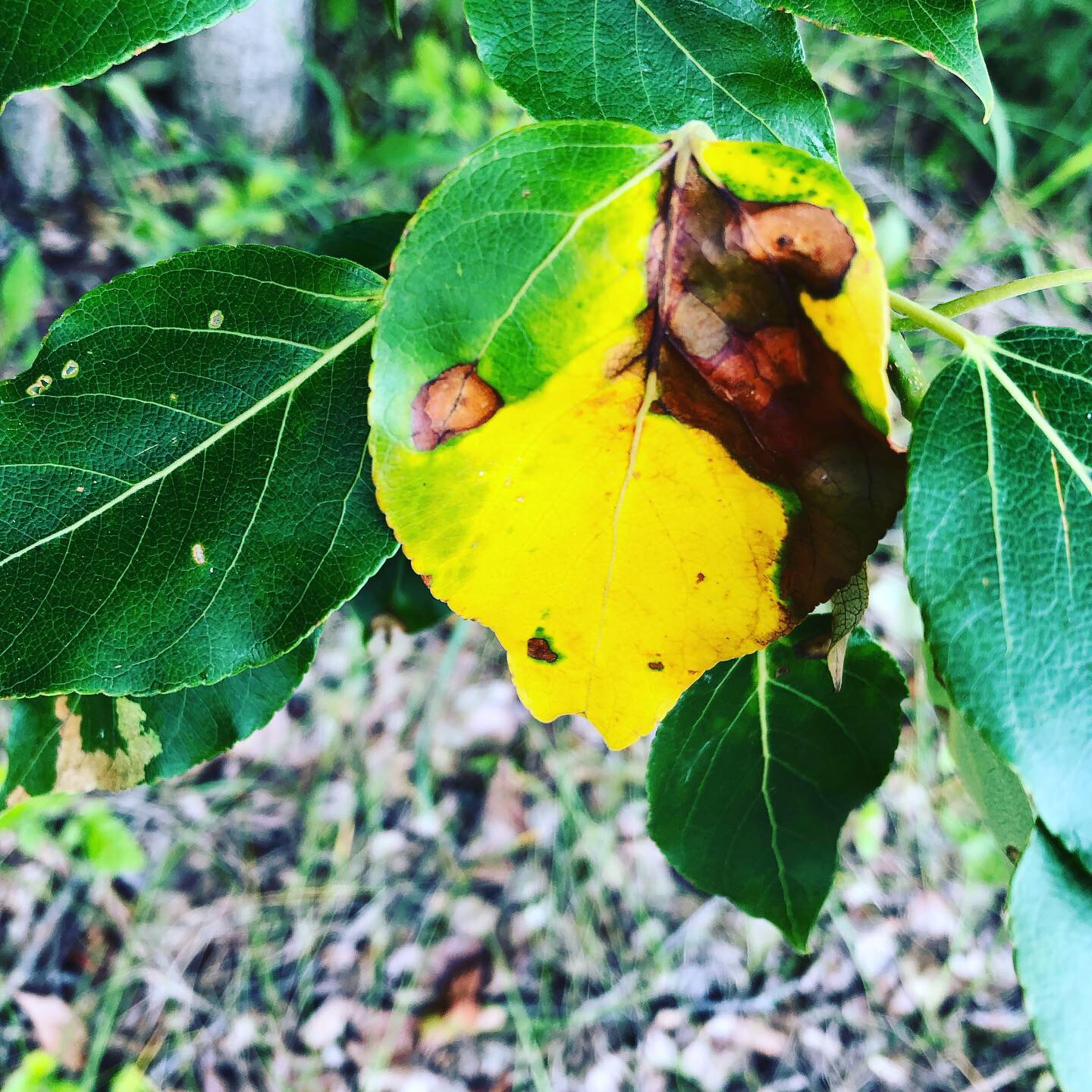
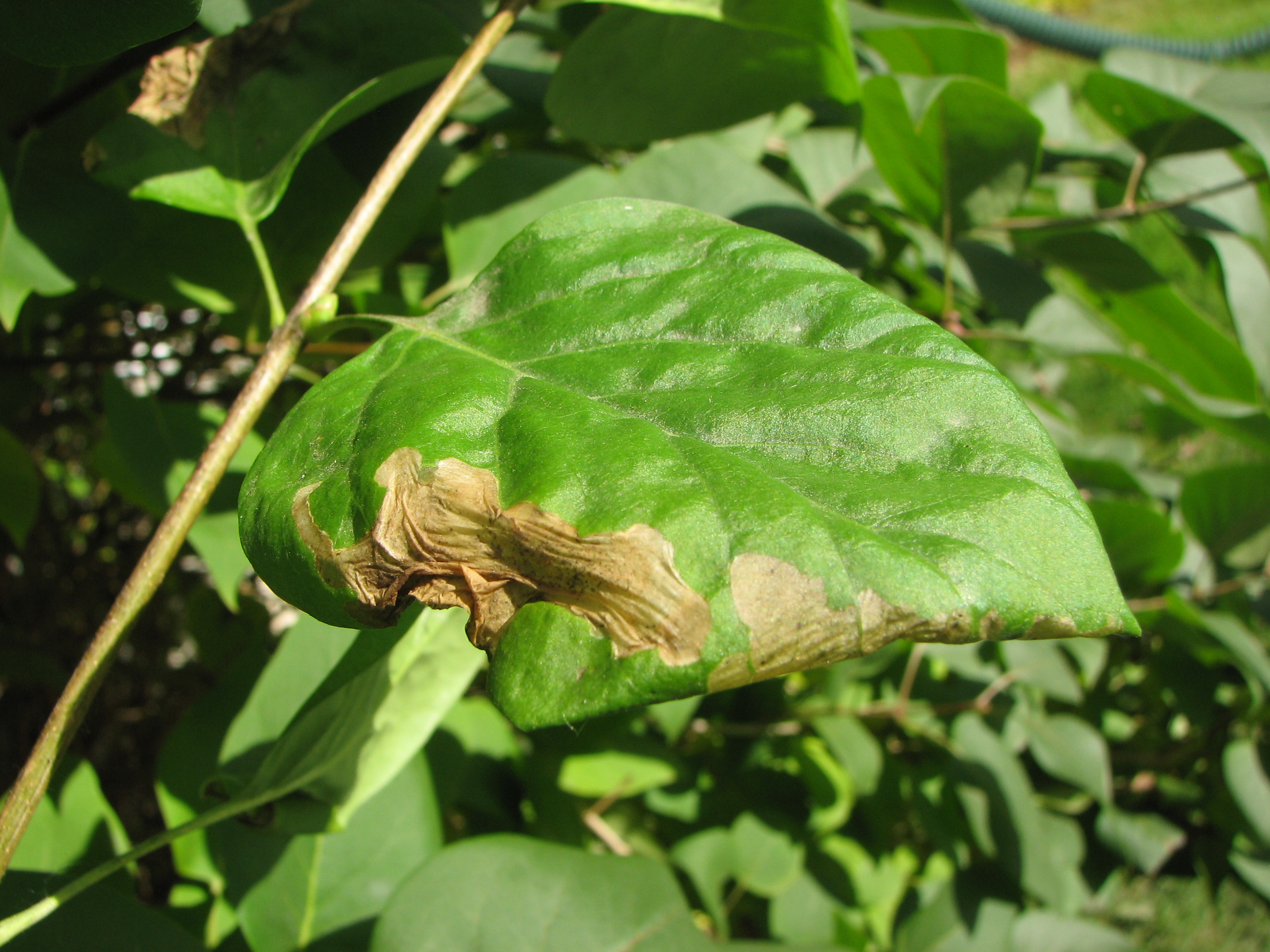
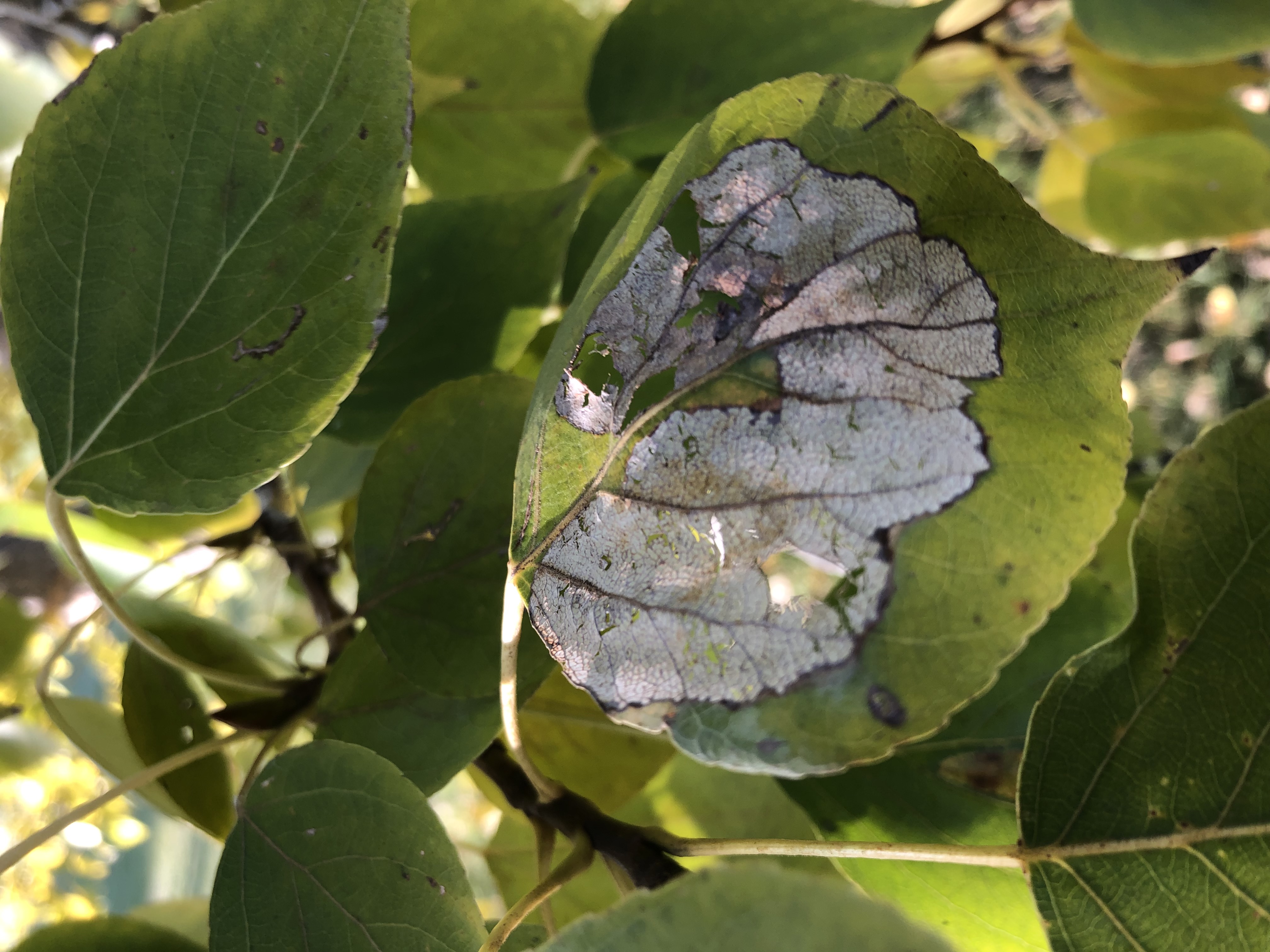
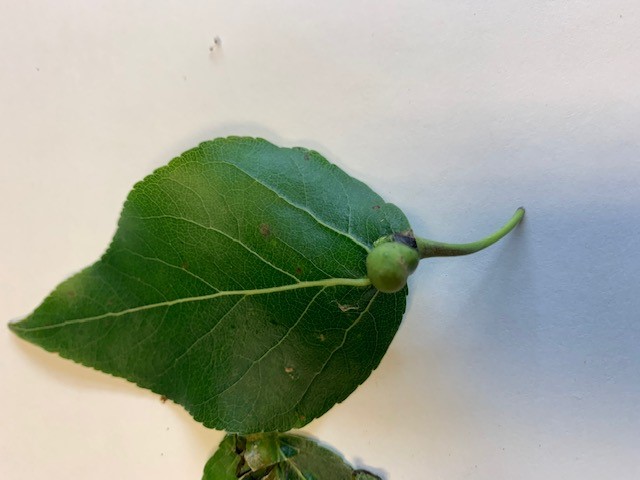
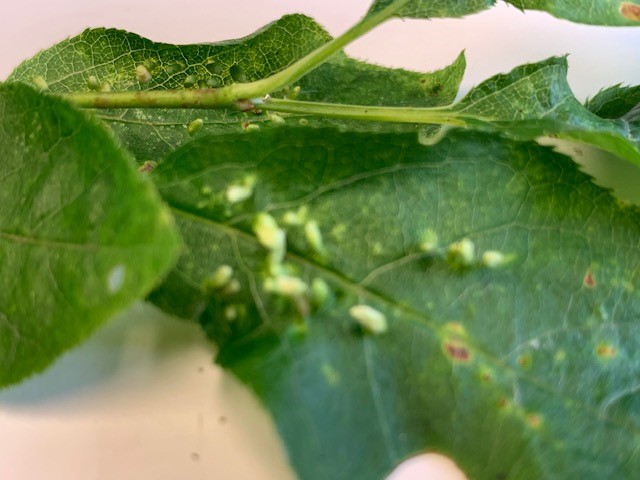
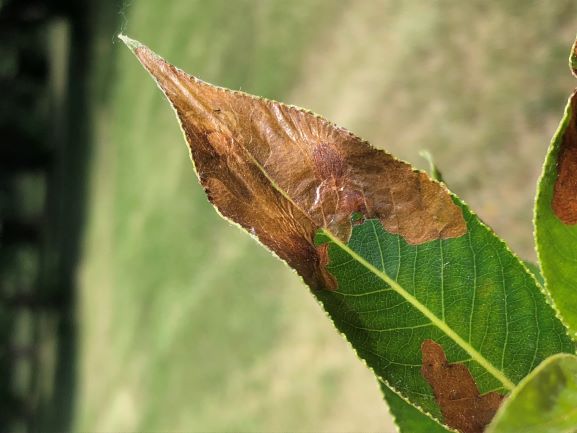
How to Distinguish Willow Leafminer from other Pests:
Leaf Spot (Fungal Disease)
- Usually small, black spots on damaged willow leaves; spots may be raised an surrounded by a yellow band (tar spot).
- No hollow area inside the leaf under the leaf spot.
- No flat caterpillars inside the leaf.
Willow Leaf Beetle
- Eat all but the upper layer of the leaf and veins.
- Either gray or yellowish brown beetles or black larvae feeding on leaves.
Flea Beetle
- Small black larvae feeding on willow leaves leaving only the mid-rib, main veins, and sometimes the upper layer of the leaf.
- Willow leaves with holes and small (5mm), shiny black or steel blue beetles that jump when disturbed.
Herbicide Damage
- Leaves discolour but no hollow area inside the leaf.
- No flat caterpillars inside the leaf.
What Tree Species are attacked by this Pest?
- They feed only on species of willow
- Most willow species are attacked by willow leafminer. Some willow species, such as Feltleaf Willow, that have the underside of leaves covered 'felt-like' with dense hair, are not attacked by this insect.
What Kind of Damage do they Cause?
- Affected leaves may drop prematurely.
- Damaged parts of leaves affect plant nutrition and tree growth.
- Severe infestations may result in branch kill.
- If consecutive years of severe leafminer damage occurs, willows under stress may be killed.
- May affect forage for wildlife, if large-scale defoliation occurs due to leafminer damage
Leaf History of Willow Leafminer
- Eggs - pale green, tiny (0.5mm in diameter) and laid individually in early summer at willow bud break on the underside of willow leaves.
- Caterpillars (larvae) when hatched feed on the upper surface of the leaf and then move between the upper and lower surfaces of leaves to feed. Caterpillar stage occurs in June. Young caterpillars are tiny (less than 1mm long) and mature caterpillars are small (4-7mm long) and flat and pale yellow in colour. They make narrow slits on the lower surface of the leaves and sliken covers to pupate.
- Pupa is a transitional stage during which the caterpillar does not feed and begins tranforming into a tiny moth.
- Adult moth is small, gray coloured and has a wingspan of about 10mm, with long antennae. Head is covered with dense hair pointing forward. Forewings are mottled with light and dark grey to brownish grey areas. Adults emerge in July-August, over winter, and emerge in the spring to mate and lay eggs.
How to Control Willow Leafminer
- Usually control measures are not necessary because leafminer outbreaks, in most cases, are controlled by natural enemies such as parasitoids, predators, and unfavourable weather conditions.
- Keeping willows healthy and vigourous helps to mitigate leafminer impact. This can be done by avoiding soil compaction, stem and root injury, and water-logging.
- Applying fertilizer during psinrg and watering willows during droughts will also help to keep leafminer impact to a minimum.
- Use leafminer resistant willow varieties to avoid leafminer problems.
- If willows of high value are at stake, you may consider use of a systemic insecticide to reduce leafminer populations. Always follow label instructions in using any pesticide to avoid undesirable effects of pesticides on non-target organisms.
Leafmining Insects - PDF Download
Leafminers are insects that have a habit of feeding within leaves or needles, producing tunneling injuries. Several kinds of insects have developed this habit, including larvae of moths (Lepidoptera), beetles (Coleoptera), sawflies (Hymenoptera), and flies (Diptera). Most of these insects feed for their larval period within the leaf. Some will also pupate within the leaf mine, while others have larvae that cut their way out when full-grown to pupate in the soil.
Leafminers are sometimes classified by the pattern of the mine which they create. Serpentine leaf mines wind snake-like across the leaf gradually widening as the insect grows. More common are various blotch leaf mines which are generally irregularly rounded. One sub-group of these are the tentiform leafminers, which produce bulging blotch-type mines that curve upwards, somewhat like a tent, as the damaged leaf tissue dries. Minin patterns often are combinations of the above, such as species that initially produce serpentine mines but terminate by making the enlarged leaf cavity out of a blotch mine.
Areas mined by insects die and dry out. Although injuries produced by leafmining insects can be unattractive, it is rare for them to significantly affect plant health. Also, most leafminers have important natural controls, which normally check populaions before too much injury is done to plants.
Injuries caused by leaf and needle mining insects can superficially resemble symptoms produced by leaf spotting fungi or other abiotic problems. They can be differentiated by pulling apart the blotchy area. If damaged by insects the leaf or needle will have a hollow area and may expose either the insect and/or its droppings (frass). Leaf spotting fungi cause these areas to collapse, without any tunnelling.
Common Leafminers of Trees and Shrubs
Sawfly Leafminers
Most sawflies chew on the surface of leaves, but four species develop as leafminrs of woody plants. Adults are small, dark-coloured, non-stinging wasps that insert eggs into the newly formed leaves. The developing larvae produce large blotch mines in leaves during late spring. The sawfly leafminers produce a single generation each year.
Elm Leafminer (Kaliofenusa ulmi) is the most important species developing on American, English, and Siberian elms. Other species include hawthorn leafminer (Profenusa canadensis) associated with Crataegus crus-galli, C. persimilis, and C. erectus; birch leafminer (Fenusa pusilla) present in some plantings of white or grey birches; and alder leafminer (Fenusa dohrnii), a native species that develops in alder leaves.
Tentiform Leafminers
Larvae of several tiny moths (Phyllonorycter species) produce blotch mines in leaves that pucker when they dry out, somewhat resembling a pup tent. These tentiform leafminers occur on willows, poplars, and cottonwoods, hackberry and apple and leaf mines tend to be concentrated on the lower, shaded leaves. Probably two generations are normally produced. Outbreaks are rare because these insects are normally heavily attacked by parasites and other natural enemies.
Lilac Leafminer
Another small moth, the lilac leafminer (Caloptilia syringella) produces a blotch mine and then folds edges of lilac and privet leaves. A related species, the boxelder leafminers (Caloptilia negundella), produces similar leaf injuries to boxelder leaves. There are two generations per year and the life cycle is likely similar to that of the lilac leafminer.
Needleminers
Several minute moths of the genus Coleotechnites have larvae that develop in the needles of conifers. Affected needles appear brown beyond the tunnels of the larvae. Most important is the ponderosa pine needleminer (Coleotechnites ponderosae) that has periodically produced outbreaks in the forested areas of ponderosa pine. Related species occur in lodgepole pine, pinyon, and spruce.
Aspen Leafminer
Delicate, winding wines through the upper leaf surface of the aspen leaves are characteristic of another small moth, Phyllocnistis populiella. The feeding by the caterpillars that produce the mines produces insignificant damage and is notably mostly because they attract attention.
Poplar Blackmine Beetle
Large black blotches in poplar leaves are produced by larvae of a beetle (Zeugophora scutellaris). Adults chew small pits in the leaf. Outbreaks are extremely rare and the insect causes only minor leaf damage.
European Elm Flea Weevil
Probably the newest leafmining insect to establish is the European elm flea weevil (Orchestes alni). The larvae make a leaf mine in elm that superficially resembles that of the elm leafminer sawfly. The mine of the European elm flea weevil originates from a leaf vein, meanders in a serpentine form, and ultimately terminates in a leaf blotch along the edge of the leaf. Adults are tiny beetles that jump which makes pits in leaves, producing a lacy appearance of foliage when they are abundant.
Management of Leafminers of Trees and Shrubs
Few, if any, leafminers pose any significant threat to the health of trees or shrubs. Injuries are cosmetic and treatment decisions are based on plant appearance.
Furthermore, most leafminers have numerous natural enemies that normally will regulate their populations. Outbreaks, if they occur, are usually very short-lived. However, exceptions to this can occur among the non-native species that are not well regulated by natural enemies. Examples of non-native leafminers are those found on elm (elm leafminer, European elm flea weevil), birch (birch leafminer), and the tentiform leafminers of apple.
If controls are attempted with insecticides there are two approaches to consider. The first involves sprays applied to leaves that are timed to coincide with periods when egg laying occurs, usually shortly after leaves have expanded in spring. Persisting contact insecticides can be used for this purpose, such as the various pyrethroids that currently predominate for control of insects that chew on leaves (permethrin, bifenthrim, lambda-cyhalothrin, cyfluthrin, deltamethrin). None of these will move systemically in plants so active larvae within mines will not be affected. Sprays of systemic neonicotinoid insecticides (imidacloprid, dinotefuran) can provide some control of these stages among leafminers that are beetles (Coleoptera) or sawflies (Hymenoptera). Neonicotinoids tend to be poor in control of caterpillars, the larval stage of moths (Lepidoptera).
Alternately, neonicotinoid insecticides can be applied to the soil for root uptake. Imidacloprid (Merit, various generics) is widely available for this application. Dinotefuran (Safari) is presently only available through commercial applicators.
Contact Us
Saddle Hills
Junction of Hwy 49 & Secondary Hwy 725
RR1, Spirit River AB
T0H 3G0
T. 780-864-3760
Fax 780-864-3904
Toll-free 1-888-864-3760
frontdesk@saddlehills.ab.ca
Sign up to our Newsletter
Stay up to date on the Saddle Hills activities, events, programs and operations by subscribing to our eNewsletters.
